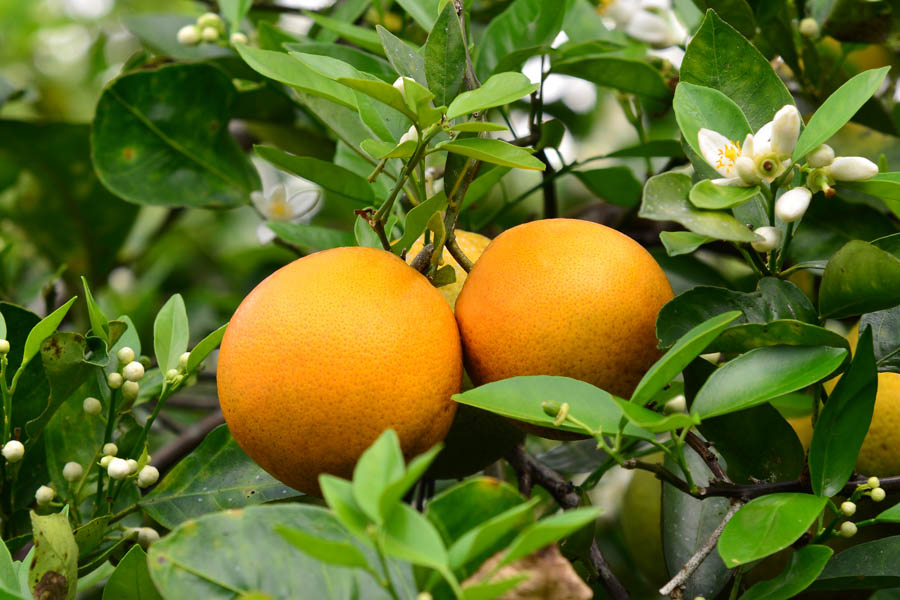Citrus Trees: 7 Common Problems

Seven problems commonly found in citrus trees and suggested solutions include:
Overwatering: Citrus may become stressed and more susceptible to pests and diseases as a result of poor drainage or standing water. Citrus and other trees have difficulty with proper nutrient uptake in wet soils.
Shallow Watering, Watering with Sprinklers, and Wetting Trunks or Major Roots: GardenZeus discourages planting orange trees in lawns or using sprinklers for watering trees. Sprinklers and other shallow surface irrigation are generally inappropriate for citrus and other trees, and may encourage root rot, other diseases and pests, shallow rooting, and other problems. Avoid wetting trunks and major roots with sprinklers, and keep the upper soil dry within tree driplines.
Chlorosis: Chlorosis is iron deficiency that appears as lightening or yellowing between veins on older leaves and/or pale green or yellow new leaves. Affected leaves will never return to normal because iron is not a mobile nutrient, meaning that it cannot be relocated within a plant. Alkaline city water and alkaline soils are common causes of chlorosis; iron becomes decreasingly available to trees when soil pH is above 6.0, and is mostly unavailable at pH of 7.0 and above. Chlorosis in citrus is often chronic due to naturally alkaline soils combined with watering over years with alkaline city water. Trees may also become chlorotic as a result of wet or waterlogged soils, anaerobic soils, root rot diseases, or damaged roots. Applying chelated iron will help temporarily but is not a long-term solution or cure, and chelated iron may rapidly become unavailable in alkaline soils. The best solutions are to encourage a thriving, healthy soil ecosystem that will naturally improve pH; or to provide acidity to soil by mulching with face-down cut halves of waste citrus, watering with diluted vinegar at proportions of about 1/4 to 1/2 cup of white vinegar in 2 gallons of water, or using an acidifying product such as pH Reducer.
Nitrogen deficiency: In contrast to chlorosis, nitrogen deficiency appears as pale or yellowing older leaves while new growth is green and healthy. Nitrogen is mobile in plants and is moved from older leaves to produce new growth. Apply a nitrogen soil drench in the form of diluted urea or chicken manure at the rate of one cup of chicken manure per four 4 gallons of water (half cup if fresh manure), mixed thoroughly, and applied near the driplines of trees a few times per year. Fresh or composted manures may be applied as a surface-dressing under mulch. Adding too much nitrogen to soils may result in lush, high-carbohydrate leaves that attract insect infestation, and may delay or reduce fruit formation if added early in the fruiting cycle.
Sunburn: Citrus bark and cambium are sensitive to sunburn, and sun protection for trunks and branches may be necessary during hot Southern California summers. Avoid thinning or removing significant portions of canopy, especially those that shade internal branches from southern and western direct sun. Sunburned stems begin to show cracked, peeling, or rough sections of bark that progress to dead sections of cambium with bare wood exposed. When these symptoms occur on south-and-west-facing citrus trunk or stem sections, they are usually caused by sunburn. To address this, trunks of young trees may be wrapped in sleeves (consider making homemade ones from paper or cardboard). Larger trunks and stems may require painting with indoor white latex paint diluted about 1:1 to 2:1 water to paint. If you find white-painted tree stems and trunks to be particularly unattractive in the garden and landscape, try a light-colored beige, tan, or similar color that blends in better with your garden; however, these paint colors will not protect stems as well as white.
Blossom and Fruit Drop: Sometimes a problem but often not. Citrus trees naturally drop many of their flowers and small, immature fruits when they are about the size of a pea, most commonly in late spring to early summer. This is a natural thinning process called “June drop” that seasonally and in reasonable proportions is not a problem. On otherwise healthy and unstressed trees, loss of the majority of flowers and up to 80% or more of the tiny immature fruits may be normal. However, if numerous fruits are dropped at about the size of a ping pong ball or larger, this usually indicates that soil, water, sunlight and/or other environmental conditions are insufficient for the tree to produce a full crop.
Split Fruit: Fruit splitting occurs with many citrus species, especially varieties that produce thin-skinned fruit, and is particularly common with navel oranges. The exact cause of citrus fruit-splitting has not been proven by research. Some orange varieties are likely more genetically susceptible than others, and splitting tends to occur with variable water or if trees become drought-stressed between waterings, especially when combined with other environmental stresses such as cold, heat, wind, nutrient deficiency(s), pests, disease, or physical injury. Splitting is more common on young, establishing, and shallow-rooted trees. Generally only a small proportion if fruit on a given tree is affected.
Splitting usually occurs before fruits are ripe, so they are rarely edible when split, and should be removed from the tree and composted, discarded, or used as an acidifying mulch under a layer of organic matter. If left on the tree, they may encourage pests and diseases. There is no short-term treatment known to be effective for citrus fruit-splitting. GardenZeus expert Darren Butler believes that the best solution is to encourage strong, healthy trees by meeting their environmental needs over a period of years, particularly with consistent and deep watering; and by feeding and nurturing soil to encourage a thriving soil ecosystem.
GardenZeus has customized information by plant and zip code. To get started, enter your zip code here.
Getting Started With Citrus: Purchasing and Placing your Citrus Trees
Mulch Around Orange Trees: Always, Sometimes or Never
Why Are Leaves Curling on My Orange and Lemon Trees?
